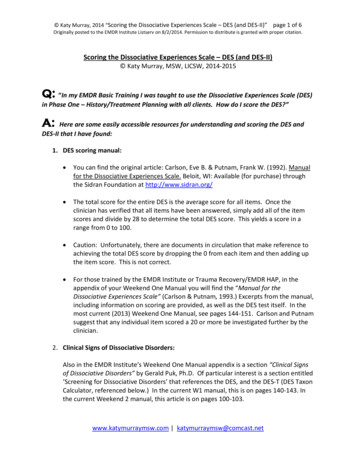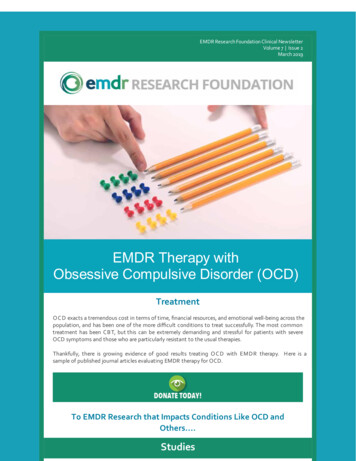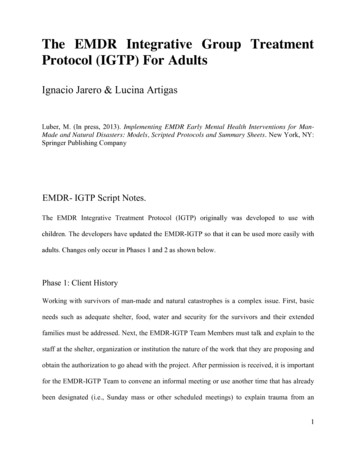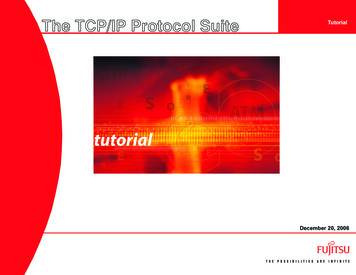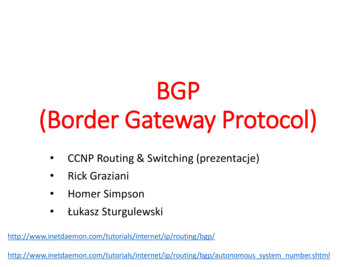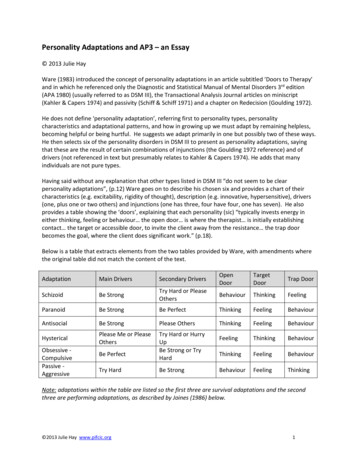
Transcription
Adaptations to EMDR Protocolfor use with ChildrenAnita SabeyEMDR ConsultantAccredited Play Therapist (BAPT)Ajsabey@aol.com
What is my clinical background? Accredited Child centred Play therapistworking within CAMHS service. Part ofMDT BACP accreditedCounsellor/Psychotherapist -PrivateEMDR clinic with all ages, including adults.
Dilemma How to be creative, and child centredwhile remaining aware of the EMDRprotocol.
EMDR with children Brevity of EMDR treatment Importance of safe place The re occurrence of symp, but fordifferent reasons than originally Lack of dramatic change within session,accompanied by dramatic change uotsideof session
Using EMDR with Children Need for parental cooperation and supportfor treatment Problem of motivating children who do notrequest treatment, or who have shortattention spans or not verbally orientated Need to creatively integrate EMDR intoother modalities
When to introduce EMDR Strong enough therapeutic relationship? Child’s level of trust? Child’s capacity for tolerating pain, anxietyand fear? Child’s attachment history? Age of child? Child’s level of motivation?
EMDR Protocol-the 8 phases ofTreatment Phase 1: Client History and Treatmentplanning. Phase 2: Preparation Phase 3: Assessment Phase 4: Desensitisation Phase 5: Installation Phase 6: Body Scan Phase 7: Closure Phase 8:Re-evaluation
Phase 1. History taking and treatmentplanning Obtain Developmental history Obtain trauma history Assess current family environment Select target to desensitise Explain EMDR to parents/carers
Phase 2: Preparation Establish Therapeutic relationship withchild Address child’s concerns Establish safety procedures (Safe place)
Phase 3: Assessment Obtain target image Obtain negative cognition Obtain positive cognition Obtain validity of cognition rating(VOC) Obtain emotions associated withthe target image Obtain a rating of emotionaldisturbance (SUDS) Obtain the physicalsensations associated withthe emotions Obtain the locations of thephysical sensations
Kid’s list of Cognitions – Adler-Tapia & SettleBad Thoughts (NC)I’m badI’m in fogI’m going to explodeI’m hotI don’t belongI’m stupidI can’t do itI don’t understandI can’t get helpI am not lovableI am uncomfortable in my skinI am fatI messed upGood Thoughts (PC)I’m goodI’m in a clear place/sunshineI’m calmI’m cool (as a cucumber)I do belongI’m cleverI can do itI do understandI can get helpI ‘m lovableI fit in my skinI’m just rightI did the best I could
Phase 4:Desensitization Follow the child’s chain of associationsusing eye movements or other BLS untilSUDS reduced to 0-1
Phase 5: Installation Pair the target memory with the positivecognition and do a set of Eye movementsor BLS. If the VOC at 7, go on to phase 6.If the VOC 7, process further until SUDSis at 0 and the VOC is up to 7
Phase 6: Body Scan Ask the child to hold the installation elements inmind and scan the body for sensations Process positive or negative sensations Generally children aged 9 can complete a bodyscan. If the child is not able to understand thebody scan, do sets of eye movements with thesafe place until the child feels safe and relaxed.
Phase 7: Closure Give closing comments to the child or tothe child and the parents together.
Phase 8: Re-evaluation At the beginning of the next session,review progress and decide on the nextcourse of action.
Safety! Alliance with parentsChild access to parentsDemonstrationRapportTherapeutic relationshipBaby stepsPositive installations/resourcesStop!
Modification age 2-3 years Omit NC, PC and VOC. Safe place –often parent’s knee! Parental knowledge used to understand trauma –often specificevents. Photos/pictures/using props/toys/play therapyUse of stories – Joan Lovett . Best if can use child’s own chains of association Not able to do EM. ( Use of drum/musical instruments/ pat-acake/moving toy / ‘tappy feet’ Parent/toys being used to show child the process.
Maddie – 2 years 9 months Regular Eye ops due to cataracts Phobia re doctors/hospitals Use of play and drumming
Age 4-5 Establish safe place, then evoke a description of anevent, then a described image of it May not manage EM, but worth trying May manage something popping up Left then right betterthan tracking No cognitions, but instead identify target, then get child’sfeelings about it. Rate using hands or verbal Use of games Use of metaphor
Max –aged 5 years Sexual abuse by neighbour Session with parent in room Use of magic wand on back of his hands Target - nightmare of ‘Tiger’ Resource work/Safe place ‘Dream catcher’
Age 6-8 May have trouble developing NC, PC and VOC May develop rudimentary pos. cog, then ‘backing intonegative cog’ May cope with SUDS or use of hands Channels short -1-10 sets of EM Therapist may need to be active to identify different aspectsof a trauma, due to lack of associative chaining Early installation –rather than cognitive interweaveMay develop ‘late positive cog. Which could be used forinstallation stage
Sami –aged 8 years Baby sister died unexpectedly –underlying heartcondition. Mother expecting another baby imminently Used the drum, within play therapy setting
Age 9-12 Very few modification required Importance of Safe place May be more able to make associativeconnections
Sara –aged 11 Been in RTA, best friend killed. Use of drawing, and theratappers Use of imaginary helper.
Jake –aged 12 History of domestic violence and abuseform step-father Use of football on string Use of punch bag –made a face to put onit! Used body diagram to show where in bodyhas feelings
Adolescence 13 -17 years Use of friends Music –both as a target, and as anauditory BLS Thera-tappers
Annie aged 15 History of sexual abuse Person centred approach using talking and art Opportunity came from piece of MusicTarget image –both music and lyricsNegative cog: my life is ruinedPositive cog: my life is goodEmotions anger/sadness/lossPhysical sensations: feeling dirty/pain inside/knot instomach SUDS: 9 Hand taps while listening to the song
Sophie -15 Abused by her teacher Anger towards parents and school Self -harming
SUDS Adaptations Use of handsHappy –sad scaleFeel-o-meterChild’s own ideas!
Developmental Modification ofEMDR ProtocolAnita SabeyEMDR ConsultantAjsabey@aol.com
BLS-Adaptations Pat -a –cakeThera-tappersButterfly hugDrum and other musical instrumentsDots on wallPuppets or toysPunch bag/kickingDancing or jogging on the spot
Resource Development and Installation forchildren used when child needs to feel stronger, and more ready to copewith EMDR processing. Identify problematic life situation What qualities/skills needed when have you felt you had these qualities/who do you know whowould cope/has these qualities?
educational/imaginal Interweaves Teach children then it is never okay for children to bemistreated even if perpetrator gives them a gift Responsibility -“ Was that your job?” Good taste to make bad taste go away! Empowerment- Teach child to have a strong voice andhow to call for help. Adolescents need guidance in developing judgement
Future templates with Children e.g. with bullying: Imagine walking past the bully feelingstrong and ‘not bothered’, head held high.
My approach to EMDR! Awareness of the protocol(s)which provides useful structure Child-centred to engage. Follow child’s lead, if can use normal protocol do, ifnot look for a way in, possibletargets/resources/creative ways of working
Useful References‘Through the Eyes of a Child: EMDR with Children’Robert Tinker and Sandra Wilson‘EMDR in Child and Adolescent Psychotherapy’-Ricky Greenwald‘EMDR and the Art of Psychotherapy with Children’ - RobbieAdler-Tapia and Carolyn Settle‘Small wonders: Healing Childhood Trauma with EMDR’- JoanLovett‘Tapping for Kids’- Angie Muccillo ( EFT,‘Feel-o-meter’)‘When something terrible happens’ – Marge Heegaard
Recognising and dealing withdissociation Use of verbal encouragementUse of touchUse of hand tapsSuggest return to safe placeReturn to target more frequentlyUse of shorter setsUse of imaginal techniques –heroMake a distinct change to enviromentBack off!
Basic Components of EMDR ImageryNegative CognitionPositive CognitionVOCEmotionSUDSPhysical SensationEye Movements/BS
and fear? Child's attachment history? Age of child? Child's level of motivation? EMDR Protocol-the 8 phases of . Use of punch bag -made a face to put on it! Used body diagram to show where in body has feelings. Adolescence 13 -17 years Use of friends
